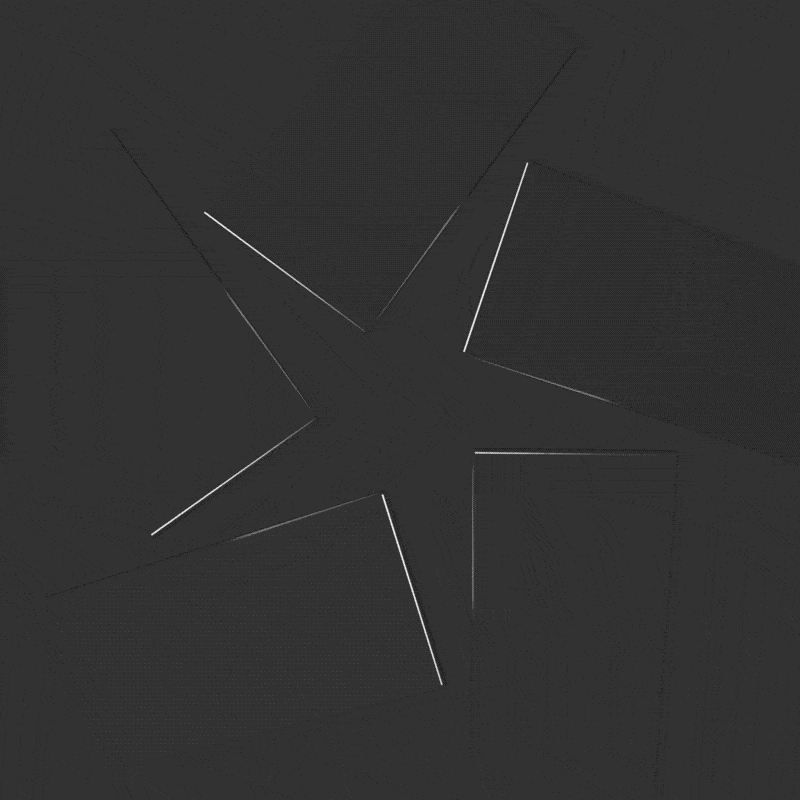1,770 days, 2,700 entries ...
Newsticker, link list, time machine: HOLO.mg/stream logs emerging trajectories in art, science, technology, and culture––every day
“Digital lines often feature perfectly straight segments, but calligraphy never has ruler-straight lines. Even in horizontal or vertical strokes, there are multiple layers of technique in the application of the brush: from the start, through the movement, to the finish. ”
Emulating the wisdom (and madness) of crowds with fantastic machines, Meriem Bennani’s “For My Best Family” opens at Fondazione Prada Milan. The sprawling kinetic installation Sole Crushing (2024, image) takes centre stage, mechanically animating 192 flip-flops and slippers to play a “ballet-symphony-riot” that sounds through an eccentric assembly and a pair of spiral sculptures. Inspired by collective ritual, the resulting din evokes “stadiums, states of delirium or hallucination, and protest.”

“It’s my attempt to portray the contemporary consciousness, what the contemporary landscape is.”

“Normality” opens at the Heidelberger Kunstverein (HKDV), showcasing early works by iconic and influential German artist Hito Steyerl. Curator Søren Grammel posits that the thorny political topics tackled by Steyerl in featured ’90s video works Babenhausen (1997) and The Empty Centre (1998) were “breeding grounds for the rise of right-wing movements and the increase in far-right violence” that now shape German politics and discourse (image: Is the Museum a Battlefield?, 2013).

“Schwartz set vividly hued pixels vibrating in eye-wateringly psychedelic works that presaged not only the widespread use of design software in the fields of art and publishing but the rise of CGI.”
“Fortunately, the sound I uttered was returned as a wave of polyphonic choral harmonies, my mediocre singing voice indiscernible from a synthetic mass of others.”
“The current backlash against ‘Generative AI’ by artists feeling appropriated seems totally disconnected from the 15‒20 year history of artists posting on corporate social media.”
Lillian F. Schwartz
(1927 – 2024)

Produced by a global collective of architects, designers, and scholars, the Feminist Spatial Practices web platform launches at e-flux in Brooklyn. Part data visualization and part activist genealogy, its interface organizes scores of feminist projects chronologically and by colour-coded themes. Similar to the Cyberfeminism Index (2020), the resource provides a rich point of entry into myriad, often overlooked, radical practices that challenge the status quo around questions of gender and equity.

“In the fifteen years that I was part of the frontline activist left, we never learned these things.”
Zooming in on the imperceptible, Sonia Leimer’s “Cosmic Dust” opens at The Cosmic House in London. Spurned by a newfound interest in microscopy, the Austrian artist deploys Dust Buddies (2023, image), a series of bronze, aluminum, and glass sculptures throughout the venue. “For an entire year, I explored a Petri dish filled with dust from the roof of The Cosmic House,” says Leimer of the micrometeoroids that inspired her. She also presents a new video about dramatic scalar shifts alongside the sculptures.

“Precisely because science fiction is so generative for our technological imaginaries, we need it to be genuinely experimental, committed to an expansive reimagining of not only what technology is, but what the future can be—and, most importantly, who gets to create it.”
September 2024
“Olafur Eliasson’s recent and more spectacular work may be the product of this frustration, of seeing so clearly the change that has come and yet feeling so acutely our inability to respond.”
Reinterpreting revered Canadian art history, Jon Sasaki’s “Homage” opens at MacLaren Art Centre in Barrie (CA). The Canadian conceptualist presents photographs of bacterial cultures grown from palettes and brushes used by the Group of Seven (image: Microbes Swabbed from a Palette Used by F.H. Varley detail, 2020). Created for a 2021 McMichael Canadian Art Collection exhibition, Sasaki intervenes in “the tradition-bound genre of landscape painting through the lens of contemporary photography.”

“Image-making software shortcuts laborious processes. Studio training gets subbed out for tutorials. Painting becomes odourless and nontoxic, offering itself up as a swipe of the mouse.”
The latest addition to the Rice Public Art initiative, Rafael Lozano-Hemmer’s Climate Parliament (2024, image) opens at Rice University in Houston (US). Installed in a public path through the Ralph S. O’Connor Building for Engineering and Science, an undulating canopy of 481 speaker-lights beam light patterns and play a dense mix of audio clips of environmentalist “protests, academic presentations, and civil disobedience” (featuring voices include Greta Thunberg and Timothy Morton) to foot traffic below.

Marietje Schaake
The Tech Coup

“I do not see as much of a discussion about who gets to decide where legitimacy to make fundamental decisions about national security or the future of use of natural resources or landscapes, where that legitimacy to decide for companies comes from, and in turn, where accountability mechanisms come from.”
Daily discoveries at the nexus of art, science, technology, and culture: Get full access by becoming a HOLO Reader!
- Perspective: research, long-form analysis, and critical commentary
- Encounters: in-depth artist profiles and studio visits of pioneers and key innovators
- Stream: a timeline and news archive with 1,200+ entries and counting
- Edition: HOLO’s annual collector’s edition that captures the calendar year in print
